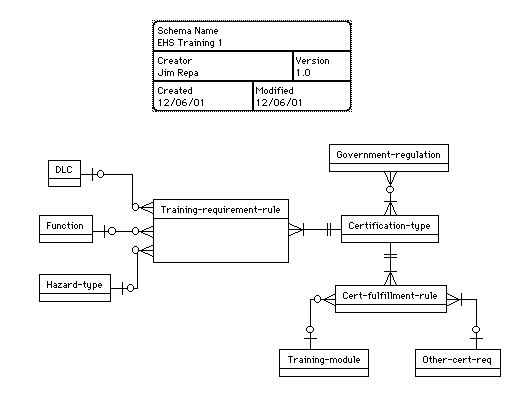
Below is a data model for the training component of the EH&S system. This is an adjunct to the main EH&S data model. (Last updated 1/25/2002.)
Let's briefly describe the entities below and what they mean. Each entity is also described in a table below the data model. There will be rules (training-requirement-rules) that state what MIT-defined certification-types a person must have based on whether the person (1) works in one or more facility (lab or other facility type) under a given DLC, (2) performs a given function (e.g., "works with chemicals") in one or more facilities, or (3) works in a facility in which there exists a given hazard-type. For any given certification-type there are a set of cert-fulfillment-rules that state which training-modules and other-cert-requirements a person needs in order to be granted the MIT certification. Since MIT defines its own certification-types, we need to define how they are associated with specific government-regulations in order to do reports for government agencies such as the EPA or OSHA in their terminology.

Description of Entities
| Entity | Description | Examples |
|---|---|---|
| DLC | A department-level organizational unit (Department, Lab, or Center) |
|
| Function | A business function that a person performs -- in this context, it will refer to a person's function within a laboratory or other facility |
|
| Hazard-type | A class of materials (chemicals, biohazards, or radioactive substances) or type of equipment which requires special training or emergency response procedures |
|
| Training-requirement-rule | One of a set of rules that determines which certification-types a person must obtain, based on the DLCs, functions, and/or hazard-types that a person is associated with |
|
| Government-regulation | A regulatory requirement from the EPA, OSHA, or other agency for which training is required. When a government agency wants a report, we translate MIT's certification-types into government-regulation descriptions. |
|
| Certification-type | MIT's local terminology for a specific "license" or group of successfully completed courses, requirements, signatures, etc., that must be granted to a person as a prerequisite for handling or working with or near a class of hazardous substances or equipment (based on government regulations and MIT policies) |
|
| Cert-fulfillment-rule | One of a set of cert-fulfillment-rules for a given certification-type that lists all of the course modules or other requirements that must be fulfilled in order to receive the given certification |
|
| Training-module | A course unit that should be taken as a prerequisite for a certification-type | |
| Other-cert-req | Something other than a training module that is part of the requirement for a certification-type |
|